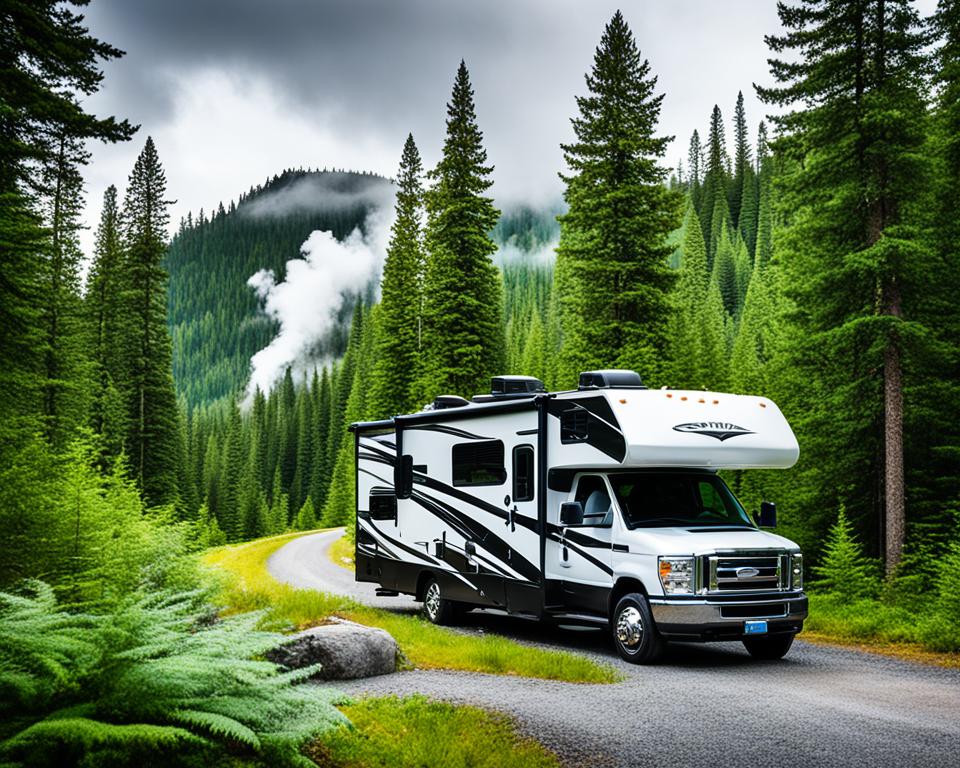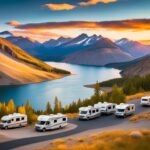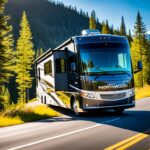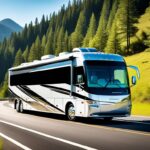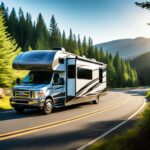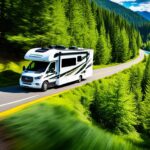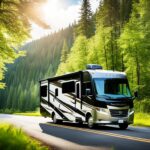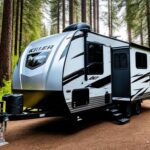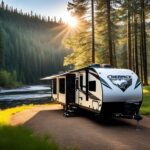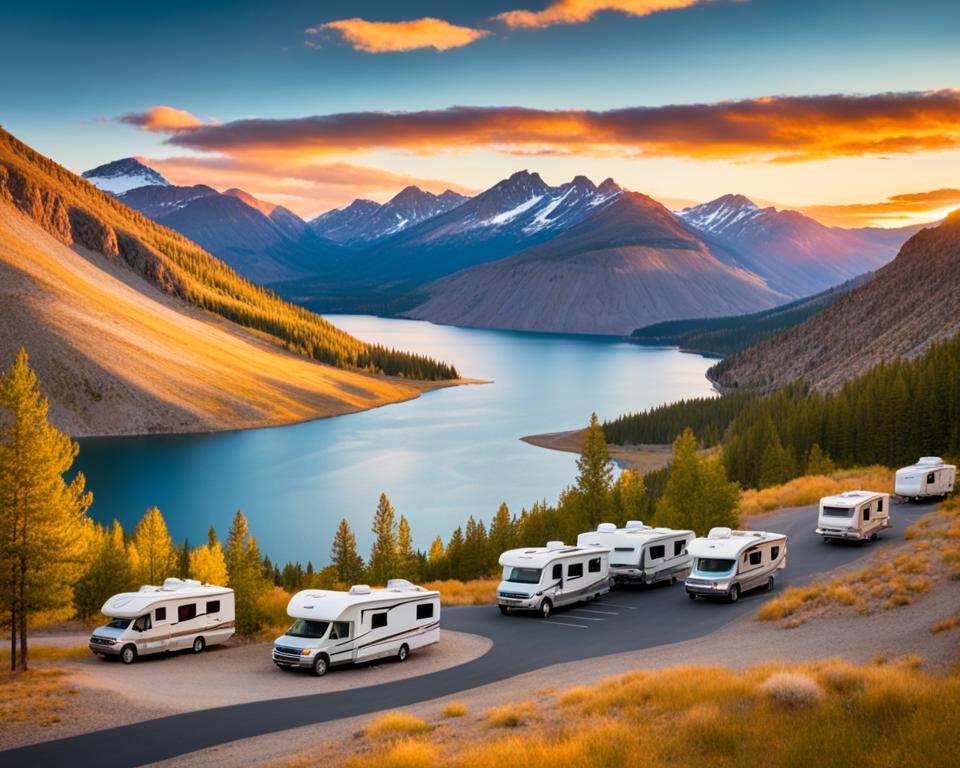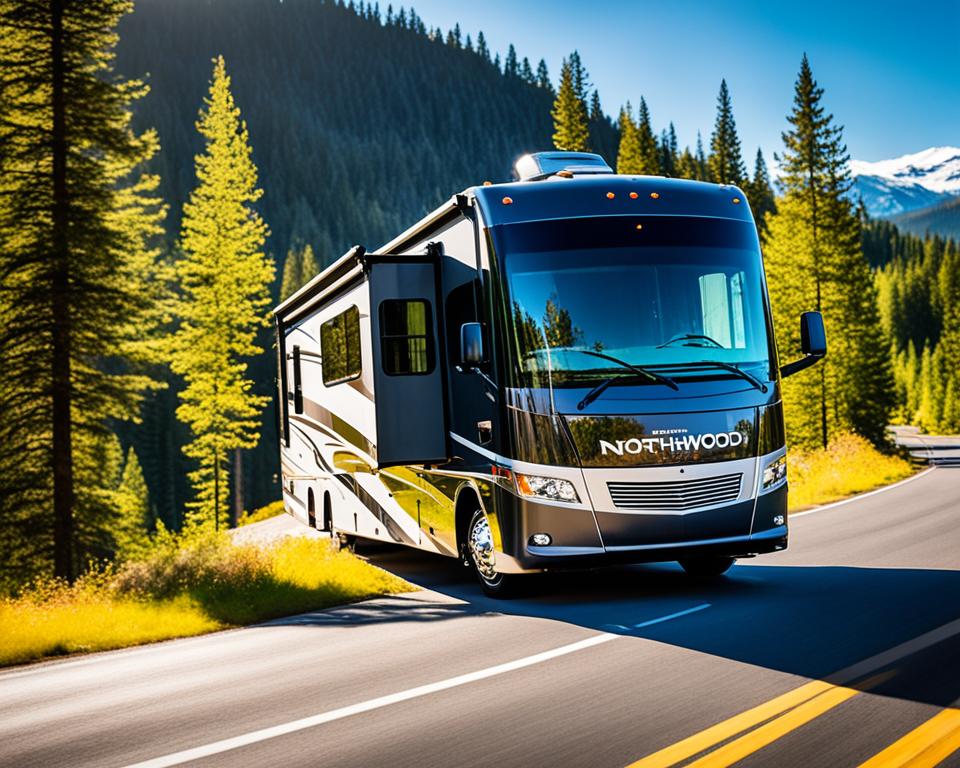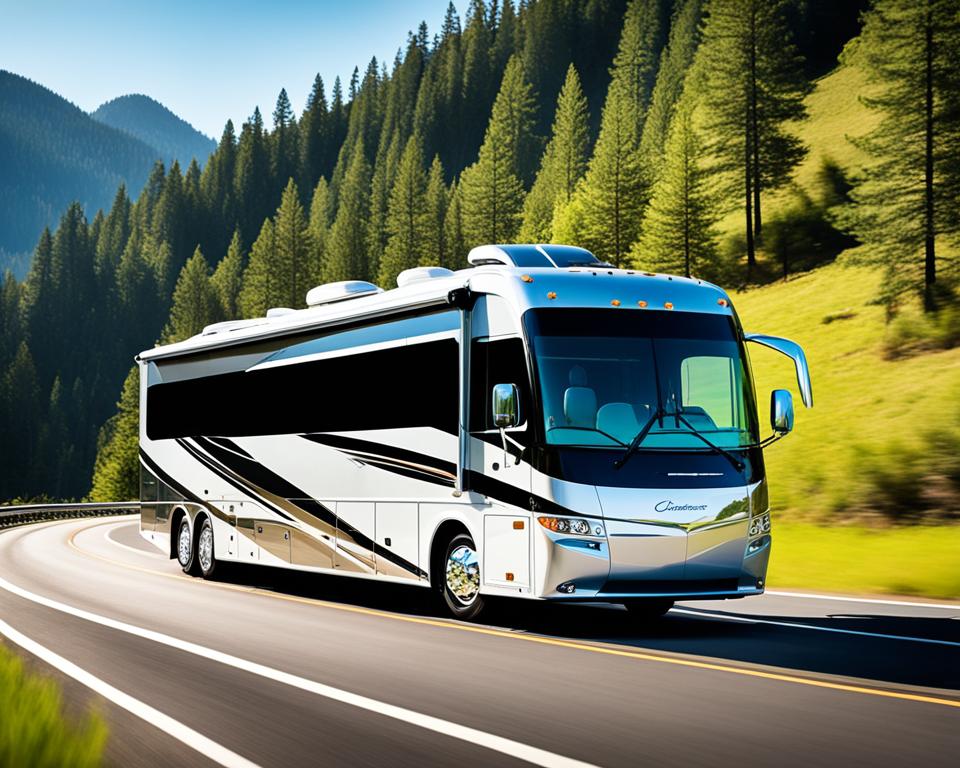RV camping has become increasingly popular in recent years, with over 600,000 campers sold in 2021 alone. National parks are a perfect destination for RVers, offering a chance to connect with nature and experience the beauty of America’s great outdoors. However, to ensure a seamless adventure, proper planning and preparation are essential. In this article, we will provide you with top tips and essential information for exploring RV life in national parks.
Key Takeaways:
- RV camping is a popular choice for exploring national parks
- Proper planning and preparation are crucial for a successful RV adventure
- Research and make campground reservations in advance
- Choose the right RV size based on park requirements and personal preferences
- Be aware of campground amenities and size restrictions
Why Plan Ahead for RV Camping in National Parks
Due to the increasing popularity of RV travel and limited campsite availability, it is crucial to plan ahead when camping in national parks. Many campsites require reservations, especially during peak seasons, and popular national parks tend to fill up quickly. By booking early, RVers can secure their preferred campsites and ensure a smooth and enjoyable experience.
Planning ahead not only guarantees a spot at the campground but also allows RVers to research important details that may impact their trip. Here are a few reasons why planning ahead for RV camping in national parks is essential:
“The early bird gets the worm.”
1. Reservations for RV Camping
Reserving a campsite in advance is the key to finding the perfect spot for your RV in national parks. Many national parks have limited campsites available, and without a reservation, you may risk finding no vacancy upon arrival. By securing your booking ahead of time, you can rest assured that you have a designated place to park your RV and enjoy the beauty of the national park.
2. Preferred Campsite Selection
Planning ahead allows you to choose the campsite that best suits your needs and preferences. Whether you prefer a site with electric hookups, waterfront views, or proximity to hiking trails, booking early gives you a better chance of snagging your ideal spot. Take advantage of online reservation systems or phone booking to select the campsite that aligns with your RV camping goals.
3. Avoiding Disappointment
Imagine arriving at a national park, excited to explore its wonders, only to find that all the campsites are full. This disappointment can easily be avoided by planning and making reservations in advance. National parks can get crowded, especially during peak seasons and holidays. By planning ahead and securing your campsite, you eliminate the risk of missing out on the RV camping experience in these breathtaking locations.
When planning your RV camping adventure in national parks, take the time to research the campground amenities, size restrictions, and any specific rules or regulations that may apply. This information will help you make informed decisions and ensure that your trip goes smoothly. Remember, early booking is the key to a successful and stress-free RV camping experience!
Choosing the Right RV Size for National Parks
When exploring national parks in an RV, it is important to choose the right size vehicle that suits your needs and aligns with the park’s requirements. RVs come in different classes, including Class B, Class C, and Class A, each offering distinct sizes and amenities.
Smaller RVs, such as Class B, are more maneuverable and can access smaller campsites that might be off-limits to larger vehicles. These compact RVs offer convenience and versatility for travelers who prioritize agility and flexibility on the road.
| RV Class | Size | Key Features |
|---|---|---|
| Class B RV | Approximately 16-22 feet | Compact and easy to drive Basic amenities and space efficiency Ideal for solo travelers or couples |
| Class C RV | Approximately 20-30 feet | More spacious than Class B Extra sleeping areas and amenities Suitable for small families or groups |
| Class A RV | Over 30 feet | Luxurious and spacious Multiple living areas and amenities Perfect for larger families or those seeking maximum comfort |
On the other hand, larger RVs like Class C and Class A provide more living space and amenities, offering a higher level of comfort during your national park adventures. However, it’s important to note that some parks may have size restrictions for RVs. Be sure to check the specific requirements of the national parks you plan to visit before selecting a larger RV.
When choosing the right size RV, it’s essential to consider your level of comfort and experience in driving different classes of vehicles. Smaller RVs may be easier to handle on narrow and winding park roads, but larger RVs can provide a more luxurious and spacious living experience. Take into account your travel preferences and priorities to find the perfect fit for your national park journey.
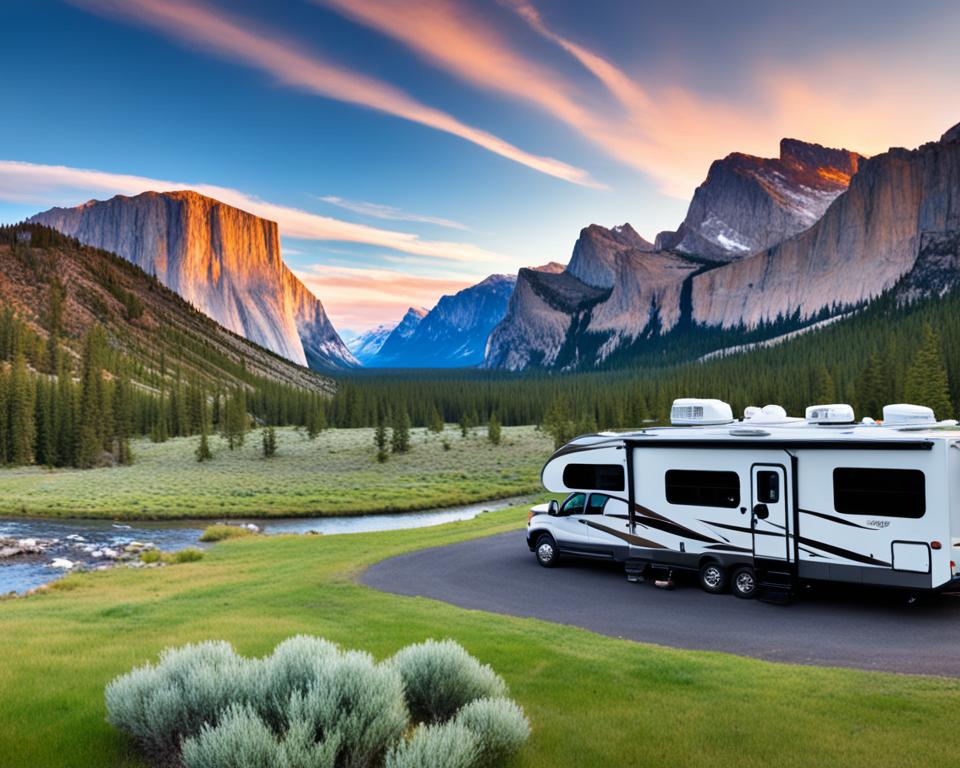
Navigating Campground Amenities and Size Restrictions
When planning an RV camping trip in national parks, it’s important to consider the campground amenities and size restrictions to ensure a comfortable and enjoyable experience. Not all national park campgrounds can accommodate large RVs or offer full hookups, so it’s crucial to research and understand the facilities and limitations of each campground before making a reservation.
Some campgrounds provide full hook-up sites with electric, water, and sewer connections, offering all the amenities you need for a convenient stay. These sites are perfect for RVers who rely on electricity for their appliances and gadgets, require running water, and prefer the convenience of sewer hookups. However, it’s essential to note that these full hook-up sites are limited in availability and may be in high demand.
On the other hand, there are campgrounds that offer only water and power hookups or have limited amenities. These sites are suitable for RVers who are willing to sacrifice some conveniences and are self-sufficient with their water supply and waste management systems. It’s essential to assess your specific needs, such as required electric service, water tank capacity, and dump station availability, when selecting a campground.
Pro tip: Before your trip, create a checklist of the amenities you consider essential for your RV camping experience. This will help you narrow down the campgrounds that meet your requirements and ensure you have everything you need.
Sample Campground Amenities Comparison:
| Campground Name | Amenities | RV Site Requirements | RV Hookups |
|---|---|---|---|
| Mountainview Campground |
|
|
Yes |
| Lakeside Campground |
|
|
Partial hookup (water and electric only) |
| Pinegrove Campground |
|
|
No hookups |
As shown in the table, different campgrounds offer varying levels of amenities and size restrictions. It’s essential to assess your RV’s size, required hookups, and personal preferences to choose a campground that aligns with your needs.
By being knowledgeable about campground amenities and size restrictions, RVers can select the most suitable campgrounds for their national park adventures and ensure a comfortable and hassle-free stay.
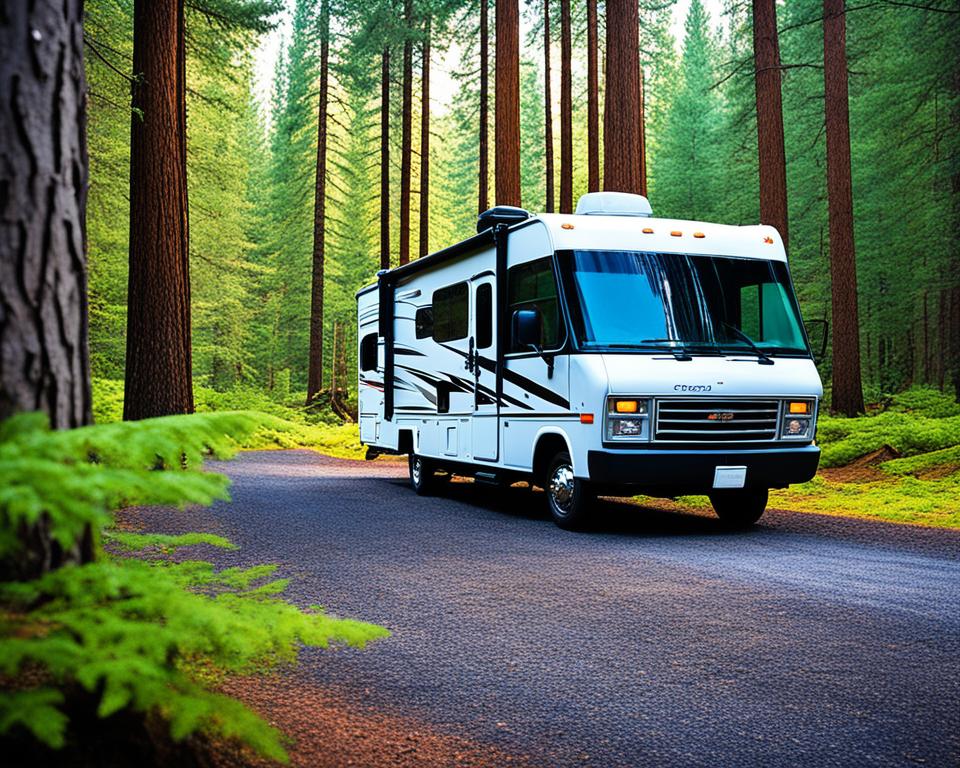
Navigating Roads and Restrictions in National Parks
When venturing into national parks with your RV, it’s crucial to navigate the roads and be aware of any restrictions that may affect your journey. Not all roads within national parks are suitable for RV travel, so it’s essential to plan your route carefully and stay informed about road conditions, height restrictions, and other potential obstacles you may encounter along the way.
One important consideration is the availability of RV-friendly roads. Some national parks have designated routes that are better suited for larger vehicles, providing wider lanes and accommodating RVs of various sizes. These RV-friendly roads ensure a smoother and safer travel experience for RVers.
Another factor to keep in mind is the road conditions within national parks. Some roads may be narrow, winding, or have steep inclines, making them more challenging to navigate for larger RVs. By researching the road conditions beforehand, you can make informed decisions about which routes to take and which areas to avoid based on your RV’s size and maneuverability.
Understanding RV Height Restrictions
RV height restrictions can pose a significant challenge when exploring national parks. Many parks have tunnels or low-clearance areas on their roads that restrict the passage of vehicles over a certain height. It’s crucial to know the height of your RV and research ahead of time if there are any height restrictions within the parks you plan to visit.
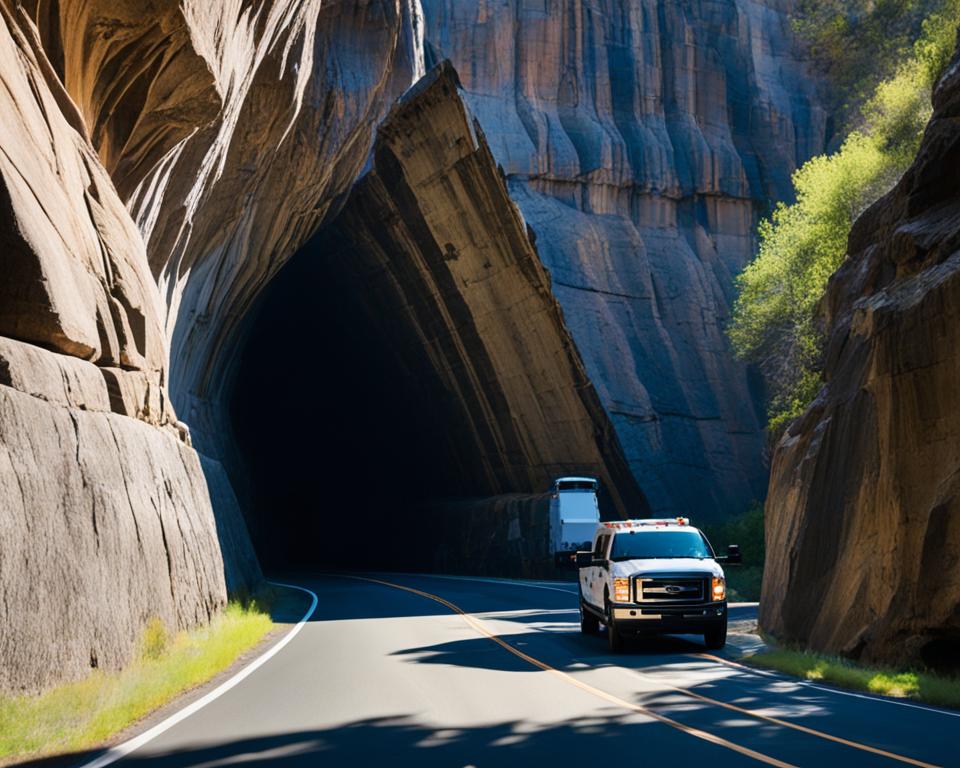
Permits are often required for oversized vehicles, such as those that exceed the height restrictions or have other size limitations. These permits allow RVers to access tunnels or roads that would otherwise be off-limits. Be sure to check the guidelines and obtain any necessary permits well in advance to ensure a smooth and uninterrupted journey through the national park.
“Navigating roads and restrictions in national parks requires careful planning and attention to detail. By understanding the road conditions, RV-friendly routes, and height restrictions, you can ensure a safe and enjoyable travel experience in these natural wonders.”
Additionally, some national parks offer alternative routes for RVs with certain restrictions. These routes might be longer or less scenic but allow RVers to circumvent areas that are impassable or unsuitable for their vehicles. Always check with park authorities or visitor centers for recommended routes for RVs to avoid any surprises during your trip.
As an RV traveler, it’s important to prioritize safety and follow all park regulations and guidelines. By being prepared and informed about road conditions, RV-friendly routes, height restrictions, and necessary permits, you can navigate the roads with confidence and enjoy the breathtaking beauty of national parks without compromising your safety or the preservation of these natural wonders.
Pet-Friendly RV Camping in National Parks
Traveling with pets in an RV can be a rewarding experience, but it is important to consider pet-friendly options when visiting national parks. While some national parks are more pet-friendly than others, RVers should be aware of campground rules regarding pets. Many campgrounds have restrictions on leaving pets unattended or require pets to be kept on a leash. RVers should plan their trips accordingly, considering pet-friendly trails and activities available within the national parks they plan to visit.
Exploring national parks with pets can offer a unique opportunity for both owners and their furry companions to enjoy the great outdoors together. However, each national park has its own set of rules and regulations when it comes to pets. It is important to familiarize yourself with these rules to ensure a safe and hassle-free experience.
When traveling with pets in an RV, it is crucial to plan ahead and choose pet-friendly campgrounds within national parks. Some campgrounds may have specific pet-friendly areas or trails where pets are allowed to roam. It is recommended to research and reserve campsites that cater to pets, as availability may be limited.
Additionally, it is important to follow campground rules and guidelines to ensure a positive experience for everyone. Common campground rules for pets include keeping them on a leash at all times, properly disposing of pet waste, and avoiding leaving pets unattended. By respecting these rules, RVers can help maintain a peaceful and enjoyable environment for all visitors.
Pet-Friendly Activities in National Parks
Aside from enjoying the scenic beauty of national parks, there are often pet-friendly activities that both you and your furry friend can partake in. Many national parks offer pet-friendly trails where leashed pets are allowed to explore the surroundings. These trails provide an opportunity for pets to exercise and enjoy nature.
Some national parks also offer pet-friendly attractions and points of interest, such as pet-friendly lookout points or picnic areas. These designated areas allow pet owners to fully experience the beauty of the park while ensuring the safety and respect of the environment.
It is always recommended to check with the national park authorities or visitor centers for the most up-to-date information on pet-friendly activities and attractions. Their knowledge and guidance can help you plan your itinerary and make the most of your pet-friendly adventures in national parks.
Pet-Friendly National Parks
| National Park | Pet-Friendly Amenities | Leash Rules |
|---|---|---|
| Yellowstone National Park | Pet-friendly trails, pet-friendly cabins | Pets must be on a leash no longer than 6 feet |
| Grand Canyon National Park | Pet-friendly South Rim trails, pet-friendly lodges | Pets must be on a leash no longer than 6 feet |
| Yosemite National Park | Pet-friendly campgrounds, pet-friendly trails | Pets must be on a leash no longer than 6 feet |
| Acadia National Park | Pet-friendly trails, pet-friendly campgrounds | Pets must be on a leash no longer than 6 feet |
| Great Smoky Mountains National Park | Pet-friendly campgrounds, pet-friendly trails | Pets must be on a leash no longer than 6 feet |
Preparing for Emergencies and Repairs in National Parks
When embarking on an RV adventure in national parks, it’s crucial to be prepared for emergencies and minor repairs. National parks are often located in remote areas, far from immediate assistance, so having the necessary tools and knowledge can make all the difference in ensuring a smooth and enjoyable experience. Here are some essential tips to help you stay prepared:
Carry Essential Tools and Supplies
Being equipped with a basic set of tools and supplies can empower you to handle minor repairs and maintenance tasks on your RV. Consider packing essentials such as a tire repair kit, a set of hand tools, spare fuses, duct tape, electrical tape, and a multi-purpose lubricant. These items can help you address common issues and keep your trip on track.
Have a Basic Understanding of RV Maintenance
Even if you’re not a seasoned mechanic, having a basic understanding of RV maintenance can go a long way in keeping your vehicle in good shape during your national park adventure. Familiarize yourself with the various systems in your RV, such as the electrical, plumbing, and propane systems. Take the time to learn how to troubleshoot common issues and perform routine maintenance tasks to prevent potential problems.
Familiarize Yourself with Nearby RV Repair Centers
Despite your best efforts, there may be times when you encounter a major repair or issue that’s beyond your ability to fix on the spot. It’s essential to research and familiarize yourself with nearby RV repair centers near the national parks you plan to visit. Knowing the locations, contact information, and operating hours of these centers can provide peace of mind, knowing that professional help is available if needed.
Know Park Closures and Alternative Campgrounds
In the event of a park closure or unforeseen emergency, it’s crucial to have a backup plan. Research alternative campgrounds or RV parks in the vicinity of your intended national park destination. Understanding their availability, amenities, and cancellation policies can allow you to adjust your itinerary seamlessly and ensure that your RV adventure continues uninterrupted.
By being prepared for emergencies and minor repairs, you can maximize your enjoyment of national park RVing and handle unexpected situations with confidence. Remember, proper planning and preparation are essential for a safe and seamless adventure in America’s breathtaking national parks.
Choosing RV Campgrounds Wisely in National Parks
When planning a trip to a national park in your RV, it’s important to choose your campgrounds wisely. With limited availability and high demand, campground selection plays a crucial role in ensuring a memorable and enjoyable experience. Here are some essential tips to help you make the right choices:
1. Make National Park Campground Reservations in Advance
National park campgrounds are highly sought after, especially during peak seasons. To secure a spot, it is advisable to make reservations well in advance. Many popular campgrounds within the parks allow reservations up to six months beforehand. By planning ahead and booking early, you can ensure that you have a guaranteed spot at your preferred campground.
2. Explore Campground Options Near National Parks
If the campgrounds within the national parks are fully booked, don’t worry! There are often private commercial RV sites located near the parks that offer additional amenities and services. These campgrounds may have a wider range of facilities, such as full hook-ups, Wi-Fi, laundry facilities, and even recreational activities. Researching and considering these nearby options can provide you with more flexibility and enhance your overall RV experience.
3. Consider Campground Amenities
Before making a reservation, it’s essential to consider the amenities offered by the campgrounds. Some campgrounds provide basic amenities like restrooms and picnic tables, while others offer more extensive facilities such as showers, dump stations, and on-site stores. Consider your needs and preferences when selecting a campground, ensuring that it can cater to your requirements for a comfortable and convenient stay.
4. Check Size Restrictions
When choosing a campground, be sure to check for any size restrictions that may impact your RV. Some national park campgrounds have limitations on the length and size of RVs that can be accommodated. You’ll want to ensure that your RV can fit within the designated campsites and that there are no restrictions that may affect your stay.
5. Read Reviews and Gather Recommendations
Before finalizing your campground selection, take the time to read reviews and gather recommendations from fellow RVers. Online forums and campground review websites can provide valuable insights into the quality and conditions of different campgrounds. Pay attention to factors such as cleanliness, noise levels, and overall customer satisfaction to make an informed decision.
Remember, choosing the right RV campground can greatly enhance your experience in national parks. Take the time to plan ahead, research your options, and consider the amenities and services that will make your stay enjoyable. By being strategic with your campground selection, you’ll be on your way to an unforgettable RV adventure.
Conclusion
RVing in national parks provides an extraordinary opportunity to immerse oneself in the breathtaking natural beauty of America. By following these essential RV travel tips, adventurers can make the most of their experience and create cherished memories that will last a lifetime.
First and foremost, it is crucial to plan and book RV campground reservations well in advance. National parks are in high demand, especially during peak seasons, and securing a spot early ensures a stress-free journey. Researching and understanding park regulations and restrictions beforehand is also vital to avoid any surprises on arrival.
Choosing the right RV size that aligns with both personal preferences and park requirements is another key consideration. Smaller RVs provide more maneuverability, while larger ones offer increased comfort. It’s essential to strike a balance that matches your driving capabilities and the specific demands of the national parks you plan to explore.
Lastly, being mindful of pet-friendly options and prepared for emergencies or repairs can make a significant difference. Knowing the pet policies of national park campgrounds and having a basic understanding of RV maintenance will ensure a smooth and enjoyable journey for both you and your furry companions. Equally important is stocking up on emergency supplies and familiarizing yourself with nearby repair centers in case of unforeseen circumstances.
Embarking on an RV adventure through national parks is an incredible way to connect with nature and discover the wonders of our country. By implementing these RV travel tips and making careful preparations, you can enhance your experience and embark on a truly unforgettable journey.
FAQ
Why is it important to plan ahead for RV camping in national parks?
Planning ahead is crucial for RV camping in national parks due to the increasing popularity of RV travel and limited campsite availability. Many campsites require reservations, especially during peak seasons, and popular national parks tend to fill up quickly. By booking early, RVers can secure their preferred campsites and ensure a smooth and enjoyable experience.
How do you choose the right RV size for national parks?
When choosing the right RV size for national parks, it is important to consider both your needs and the park’s requirements. RVs come in different classes, including Class B, Class C, and Class A, each offering different sizes and amenities. Smaller RVs are more maneuverable and can access smaller campsites, while larger RVs provide more comfort but may have restrictions in certain parks. It is recommended to consider your level of comfort in driving different RV sizes and the specific requirements of the national parks you plan to visit.
What should I know about campground amenities and size restrictions?
Not all national park campgrounds can accommodate large RVs or offer full hookups. It is essential to research and understand the amenities and size restrictions of each campground before making a reservation. Some campgrounds provide full hook-up sites with electric, water, and sewer connections, while others offer only water and power or may have limited amenities. RVers should also consider their specific needs, such as required electric service, water tank capacity, and dump station availability when selecting a campground.
How do I navigate roads and restrictions in national parks?
Not all roads in national parks are suitable for RV travel. RVers should be aware of road conditions, height restrictions, and other potential obstacles when planning their routes. Some national parks have tunnels or narrow roads that require permits for oversized vehicles. It is crucial to know the dimensions of your RV and research any road restrictions or advisories before embarking on your journey to ensure a safe and enjoyable experience in the national parks.
Are national parks pet-friendly for RV camping?
While some national parks are more pet-friendly than others, RVers should be aware of campground rules regarding pets. Many campgrounds have restrictions on leaving pets unattended or require pets to be kept on a leash. RVers should plan their trips accordingly, considering pet-friendly trails and activities available within the national parks they plan to visit.
How should I prepare for emergencies and repairs in national parks?
National parks are often located in remote areas, and RVers should be prepared for emergencies and minor repairs. It is recommended to carry essential tools and supplies for minor repairs and have a basic understanding of RV maintenance. Additionally, RVers should familiarize themselves with nearby RV repair centers and know their cancellation policies and potential alternative campgrounds in case of park closures or emergencies. Proper preparation can ensure a smooth experience even in unexpected situations.
How do I choose RV campgrounds wisely in national parks?
With limited availability and high demand, it is crucial to choose RV campgrounds wisely when visiting national parks. Some campgrounds within the parks may fill up quickly, especially during peak seasons, so it is advisable to make reservations well in advance. If national park campgrounds are fully booked, there are often private commercial RV sites located near the parks that offer additional amenities and services. Researching and selecting the right campgrounds can enhance the overall RV experience in national parks.
What are some tips for RVing in national parks?
RVing in national parks offers a unique and unforgettable way to explore the natural beauty of America. By following proper planning and preparation tips, RVers can make the most of their experiences and create lifelong memories. From choosing the right RV size and campground to navigating park restrictions and being mindful of pet-friendly options, each step contributes to a seamless and enjoyable RV adventure in national parks. Remember to book campgrounds early, research park regulations, and be prepared for unexpected situations to maximize your RVing experience in national parks.

